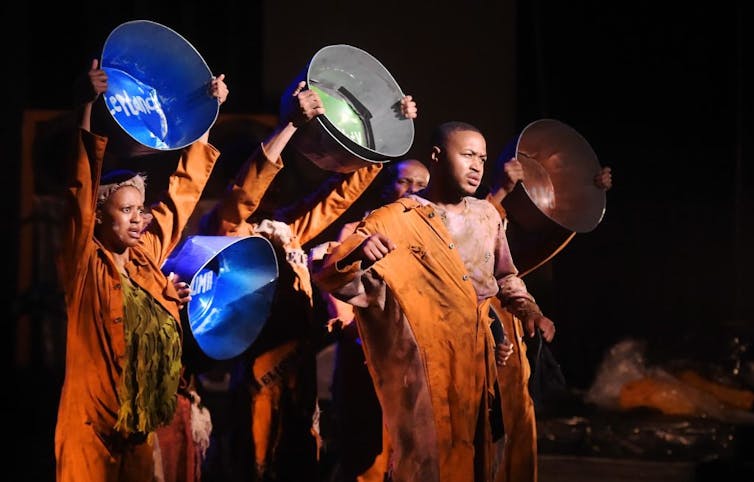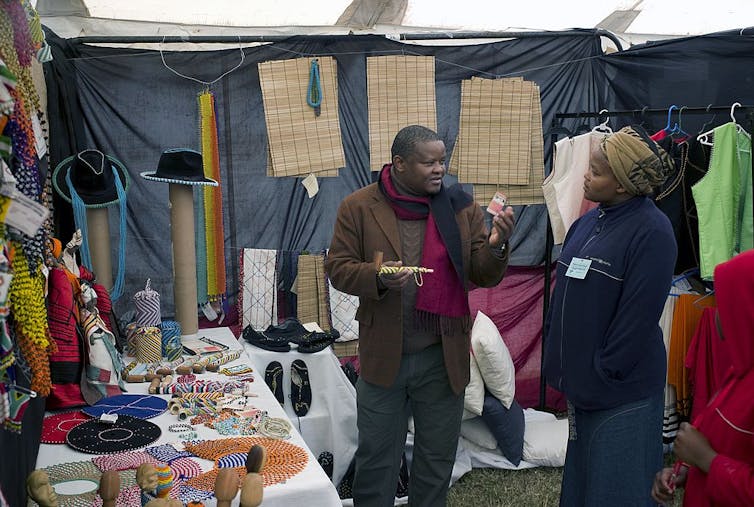The National Arts Festival was established in 1974 in Grahamstown (now Makhanda) in South Africa’s Eastern Cape province. Each year, in winter, the rural town transforms into a hive of theatres, galleries, markets and eating spots.
South Africa’s longest running festival has lived through and reflected a turbulent history: from the height of the racist apartheid system and the advent of democracy to life today in what remains a deeply unequal society.
How does one assess the impact of a festival like this? Jen Snowball is a cultural economist who’s set out to answer that question. She’s also the co-founder of the open-access African Journal of Creative Economy. She believes impact can be judged in terms of economics, artistic value, social value, and sustainability. We asked her to elaborate.
What has the economic impact been?
As in many countries, cultural policy in South Africa has increasingly emphasised the important economic roles of the cultural and creative industries. Research by the South African Cultural Observatory and others indicates the sector contributes nearly 3% to South Africa’s gross domestic product. It accounts directly and indirectly for nearly 900,000 jobs. In a country struggling with high unemployment and inequality, this economic benefit is an important part of justifying public spending on events like the National Arts Festival.

For Makhanda the festival provides an important source of income, driven by the spending of festival organisers, sponsors, artistic producers and tourists. The impact on Makhanda is not only from direct spending there, but also from this money staying in the city and being re-spent by the residents who earned it. This has an indirect impact on other local businesses. In 2019, the economic impact of the festival on Makhanda’s economy was estimated to be US$4.5 million. (The 2019 report is not publicly available but is quite similar in structure and results to the 2016 version.)
Money matters, especially for non-profit organisations like the National Arts Festival. Although festivals generate economic benefits for their host cities, most rely heavily on sponsorship from both government and the private sector. This is especially the case with this festival, which has remarkably low ticket prices and charges no entry fee for art exhibitions, the craft market and some public performances. While this business structure promotes broader access, it does make the festival more vulnerable to economic downturns. These can reduce both ticket sales and sponsorship.
And its impact in terms of cultural and artistic value?
This is the most obvious value associated with cultural festivals, but the most mysterious and difficult to describe and measure. Research has only started to explore artistic value. It’s essentially what is experienced by the audience and depends on the emotions, knowledge and history that each person brings. In a very real way, intrinsic cultural values are co-created between audiences and artists in the moment of consumption.
Diverse mixed arts festivals like this one play an essential role here on both the production and demand side. Our research has shown that National Arts Festival audiences are more likely to experiment at festivals than at other times – they take risks and go to shows and exhibitions that they wouldn’t ordinarily attend. This willingness builds up the taste and cultural capital that fuel the participation that the creative sector relies on. It also builds identity and wellbeing.

On the production side, a festival like this is an important testing ground for artistic producers. They try out new things, get feedback, share expertise, find future collaborators and are spotted by the directors of other festivals looking for talent.
What about its social value?
Part of the magic of festivals is being able to share experiences with others. Our research has shown that a big part of the value of the National Arts Festival is social. People from different backgrounds and cultures get to mix informally and talk to each other at events like the Sundowners concert – a free performance where festival artists showcase their work – and the Long Table – a pop-up restaurant in a church hall where festinos eat and talk together.
Our audience survey shows that people agree that their festival experiences give them new topics to talk about, building up their social capital long after the event itself has passed.
Our research showed that during apartheid, the festival played a role of social value in providing a platform for protest against the white minority regime and for promoting black artists. The main programme in 1984, for example, included high profile black actors like John Kani. The following year Young Artist Awards were given to playwright Maishe Maponya and and tenor Sidwell Hartman. The festival also helped develop the profile of black African cultures and cultural forms which had previously been devalued and underfunded.

And festivals are often strongly linked to place – in this case Makhanda. Our research during COVID showed that many festivals, including this one, take part of their unique identity from the culture and history of their host city. Moving online provided important benefits, like continuity and increased access for people who would not normally be able to travel to the festival. But it also reinforced the importance of place for the particular flavour of the National Arts Festival experience. Although many online festival participants appreciated what was on offer, the majority said that they would prefer to return to the in-person experience. Even when accessing festival content online, some people arranged “watch parties” so that they could still capture some of the social experience.
What does the future hold for a festival like this?
Old festivals with long histories can find it difficult to change. Disruptive technologies, like digital content platforms and artificial intelligence will undoubtedly continue to demand innovation and flexibility from the cultural sector. And increasing concerns about climate change have made many large-scale tourist events, including the National Arts Festival, think about how to reduce their environmental impact and build sustainability.
Read more: Africa's oldest dance festival evolves to overcome the pandemic
Audiences now have access to an unprecedented amount of cultural content online. They want to engage with and comment on their cultural experiences in new ways. Interviews with National Arts Festival organisers revealed that COVID, while presenting an unprecedented crisis for the cultural sector, also provided an opportunity to reimagine the future of the festival.
The next 50 years will undoubtedly see dramatic changes to this festival, but also hopefully the retention of the many unique values that it provides.

